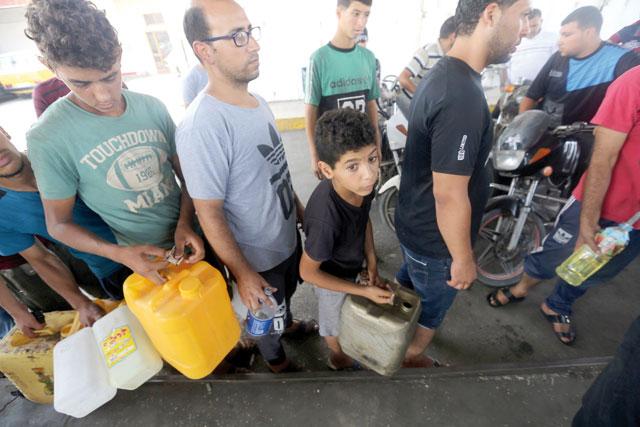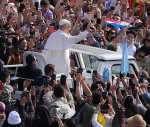You are here
Israel partially re-opens only goods crossing with Gaza
By AFP - Jul 24,2018 - Last updated at Jul 24,2018

Palestinian children demonstrate with signs and candles at the Erez crossing with Israel near Beit Hanoun in the northern Gaza Strip on Tuesday against Israel’s blockade on the enclave (AFP photo)
OCCUPIED JERUSALEM — Israel partially re-opened its only goods crossing with the Gaza Strip on Tuesday after a two-week closure prompted by border tensions sparked fears of a severe fuel shortage in the blockaded Palestinian enclave.
Fuel trucks began entering through the Kerem Shalom crossing at noon, while food and medicine deliveries that had not been subject to the closure were set to continue.
But other types of goods will remain off-limits for now as Israel continues to demand a complete end to the kites and balloons they claim have been carrying flaming cargo over the border to set alight Israeli farmland.
“Defence Minister Avigdor Lieberman decided that Kerem Shalom will partially re-open and as of today at 12:00 pm (0900 GMT) it will be possible to transfer gas and fuel into the Gaza Strip, in addition to food and medicine,” Lieberman’s office said.
The statement noted that the number of kites and balloons carrying firebombs into Israeli territory had been reduced, but claimed some were still being launched.
Palestinians in Gaza see the kites and balloons as legitimate resistance against Israel’s oppressive 10-year blockade.
As of Tuesday afternoon, Hamas had not responded to the partial reopening.
The Israeli move followed urgent warnings from United Nations officials that emergency fuel supplies were running low in Gaza and the shortage was beginning to affect hospitals and water sanitation.
The coastal enclave suffers from a severe lack of electricity and relies on fuel-powered generators during outages that last hours at a time.
‘Fast depleted’
There have been months of tension between Israel and Hamas that saw two separate flare-ups over the past couple of weekends.
The escalation has led to fears of another escalation in conflict between the two sides, who have fought extensively since 2008.
Following the latest round of violence on Friday, Israel and Hamas reached a ceasefire brokered by Egypt and UN officials that has since largely held.
Israel had carried out a wave of air strikes that killed three Hamas soldiers after one of its occupation force members was shot dead along the Gaza border earlier that day.
At least 149 Palestinians have been killed in Gaza by Israeli fire since March 30. The occupation soldier shot dead on Friday was the first Israeli killed.
The weekend before saw the most serious exchange of fire between Israelis and Palestinians in Gaza since the last war in 2014.
Israel announced on July 9 that the goods crossing was being closed to most deliveries, partly in response to the firebombs and other incidents along the border fence.
On July 17, it further tightened the restrictions to also prevent fuel deliveries while reducing the fishing zone Israel enforces off Gaza from 9.6km to 4.8km.
Tension along the Gaza border increased when mass protests and clashes began in late March. They have continued at varying levels since then.
Israel says its blockade is necessary to keep Hamas from obtaining weapons or materials that could be used for military purposes.
But UN officials and rights groups have repeatedly called for the blockade to be lifted, citing worsening humanitarian conditions in the enclave of 2 million people.
Beyond the electricity crisis, there is a lack of clean water and other infrastructure in the Strip, where poverty and unemployment are rife.
The UN humanitarian coordinator for the Palestinian territories, Jamie McGoldrick, said on Sunday that “supplies of emergency fuel provided by the UN for critical facilities in Gaza are being fast depleted”.
He called on Israel to end restrictions on fuel imports and warned that hospitals could soon be forced to close, with emergency supplies set to run out in early August.
Gaza’s only other goods crossing is at Rafah on the Egyptian border.
That checkpoint had largely been kept closed in recent years, but Egypt opened it in mid-May and it is has mostly remained so since.
Related Articles
OCCUPIED JERUSALEM — Israel said on Monday it was closing the Gaza Strip's main commercial crossing and limiting the Palestinian coastal enc
OCCUPIED JERUSALEM — Israel tightened its blockade of the Gaza Strip on Tuesday, partly over kites carrying firebombs to set alight Israeli
OCCUPIED JERUSALEM — Israel reimposed a blockade on fuel deliveries to Gaza on Thursday, citing a resurgence in kites carrying firebombs ove
















